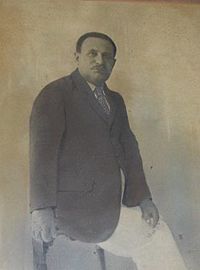Dossabhoy Muncherji Raja facts for kids
Dossabhoy Muncherji Raja (1873–1947) was a very important person in British India. He was the first Indian person to become the 'Principal Appraiser' for precious stones. This job was for the customs office in the Bombay Presidency, which is now part of India.
Contents
Who Was Dossabhoy Muncherji Raja?
Dossabhoy Muncherji Raja was born in 1873 in Bombay, which is now called Mumbai. He worked for the government's customs office. His special job was to check and value precious stones like diamonds and rubies. He made sure that the right taxes were paid on these valuable items when they entered or left the country.
He was a member of the Parsi people, who follow the Zoroastrian religion. He lived in a place called Dadar Parsi Colony in Bombay.
A Special Honor: The Khan Sahib Title
Dossabhoy Raja received a special award called 'Khan Sahib' on January 2, 1933. This honor was given to him by the top British official in India at the time, Lord Willingdon. It was a big deal because it showed how much the government appreciated his hard work and bravery.
Catching Smugglers: A Brave Mission
Dossabhoy Raja earned his 'Khan Sahib' title because he helped catch a group of smugglers. Smugglers are people who secretly bring illegal goods into or out of a country to avoid paying taxes.
To catch them, Raja went on a very risky mission. He secretly traveled to a place called Jamnagar in Gujarat. At that time, Jamnagar was ruled by a local leader called a Nawab, and it was outside the areas directly controlled by the British.
Raja dressed up like a local Gujarati trader, wearing a traditional dhoti. This way, no one would suspect he was a government official. He risked his life to gather information about the smugglers who were operating near the borders of the Bombay Presidency. The information he collected was very important and led to the arrest of the entire smuggling gang.
His bravery and cleverness in this mission were recognized with the 'Khan Sahib' medal and a special certificate called a Sanad. Today, these valuable items are still kept by his family in Mumbai.
Images for kids





